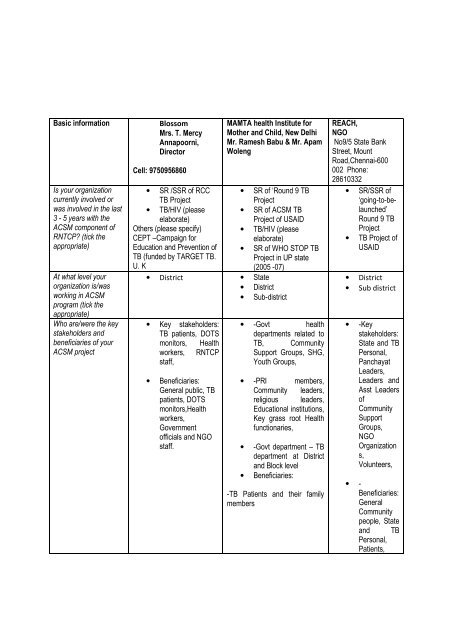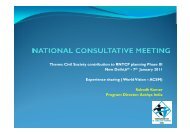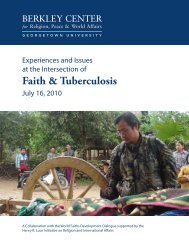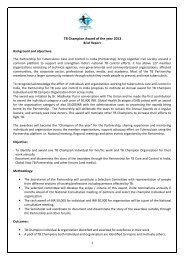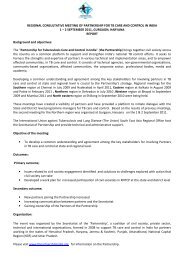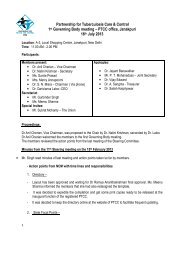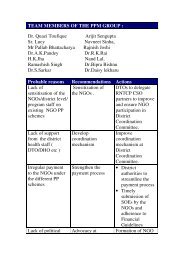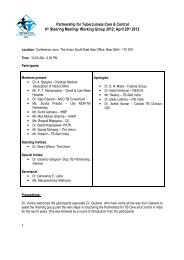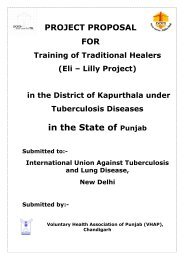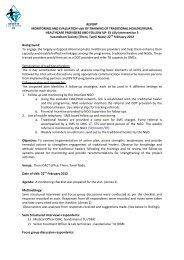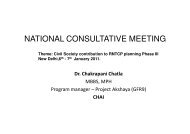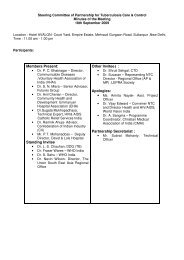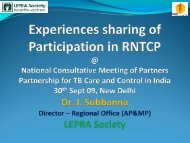5. ACSM Questionnaire filled - Partnership for TB Care and Control ...
5. ACSM Questionnaire filled - Partnership for TB Care and Control ...
5. ACSM Questionnaire filled - Partnership for TB Care and Control ...
Create successful ePaper yourself
Turn your PDF publications into a flip-book with our unique Google optimized e-Paper software.
Basic in<strong>for</strong>mation<br />
Is your organization<br />
currently involved or<br />
was involved in the last<br />
3 - 5 years with the<br />
<strong>ACSM</strong> component of<br />
RNTCP? (tick the<br />
appropriate)<br />
At what level your<br />
organization is/was<br />
working in <strong>ACSM</strong><br />
program (tick the<br />
appropriate)<br />
Who are/were the key<br />
stakeholders <strong>and</strong><br />
beneficiaries of your<br />
<strong>ACSM</strong> project<br />
Blossom<br />
Mrs. T. Mercy<br />
Annapoorni,<br />
Director<br />
Cell: 9750956860<br />
• SR /SSR of RCC<br />
<strong>TB</strong> Project<br />
• <strong>TB</strong>/HIV (please<br />
elaborate)<br />
Others (please specify)<br />
CEPT –Campaign <strong>for</strong><br />
Education <strong>and</strong> Prevention of<br />
<strong>TB</strong> (funded by TARGET <strong>TB</strong>.<br />
U. K<br />
MAMTA health Institute <strong>for</strong><br />
Mother <strong>and</strong> Child, New Delhi<br />
Mr. Ramesh Babu & Mr. Apam<br />
Woleng<br />
• SR of ‘Round 9 <strong>TB</strong><br />
Project<br />
• SR of <strong>ACSM</strong> <strong>TB</strong><br />
Project of USAID<br />
• <strong>TB</strong>/HIV (please<br />
elaborate)<br />
• SR of WHO STOP <strong>TB</strong><br />
Project in UP state<br />
(2005 -07)<br />
• District • State<br />
• District<br />
• Sub-district<br />
• Key stakeholders:<br />
<strong>TB</strong> patients, DOTS<br />
monitors, Health<br />
workers, RNTCP<br />
staff,<br />
• Beneficiaries:<br />
General public, <strong>TB</strong><br />
patients, DOTS<br />
monitors,Health<br />
workers,<br />
Government<br />
officials <strong>and</strong> NGO<br />
staff.<br />
• -Govt health<br />
departments related to<br />
<strong>TB</strong>, Community<br />
Support Groups, SHG,<br />
Youth Groups,<br />
• -PRI members,<br />
Community leaders,<br />
religious leaders,<br />
Educational institutions,<br />
Key grass root Health<br />
functionaries,<br />
• -Govt department – <strong>TB</strong><br />
department at District<br />
<strong>and</strong> Block level<br />
• Beneficiaries:<br />
-<strong>TB</strong> Patients <strong>and</strong> their family<br />
members<br />
REACH,<br />
NGO<br />
No9/5 State Bank<br />
Street, Mount<br />
Road,Chennai-600<br />
002 Phone:<br />
28610332<br />
• SR/SSR of<br />
‘going-to-belaunched’<br />
Round 9 <strong>TB</strong><br />
Project<br />
• <strong>TB</strong> Project of<br />
USAID<br />
• District<br />
• Sub district<br />
• -Key<br />
stakeholders:<br />
State <strong>and</strong> <strong>TB</strong><br />
Personal,<br />
Panchayat<br />
Leaders,<br />
Leaders <strong>and</strong><br />
Asst Leaders<br />
of<br />
Community<br />
Support<br />
Groups,<br />
NGO<br />
Organization<br />
s,<br />
Volunteers,<br />
• -<br />
Beneficiaries:<br />
General<br />
Community<br />
people, State<br />
<strong>and</strong> <strong>TB</strong><br />
Personal,<br />
Patients,
Beneficiaries<br />
of NGO’s<br />
Specific questions in<br />
<strong>ACSM</strong> programs<br />
Enlist the key activities<br />
already per<strong>for</strong>med or<br />
being per<strong>for</strong>med by<br />
your organization in the<br />
respective areas of<br />
<strong>ACSM</strong><br />
Advocacy<br />
- Formation of <strong>TB</strong><br />
Association with <strong>TB</strong> patients<br />
& cured patients<br />
For Advocacy.<br />
- Formed a State level<br />
Women NGO’ Network <strong>for</strong><br />
addressing <strong>TB</strong><br />
-<br />
-<br />
- One to one meeting with<br />
DTO/STOs<br />
- Media advocacy<br />
- Capacity building of NGOs<br />
on advocacy skills<br />
- Participation in RNTCP<br />
review Meeting at District<br />
<strong>and</strong> State<br />
- Advocacy workshop with<br />
govt officials<br />
Field visit by Govt officials –<br />
DTO/STLS<br />
Regular Meetings with<br />
RNTCP teams at<br />
District level about<br />
participation of<br />
community in <strong>TB</strong><br />
control.<br />
Meetings with NRHM<br />
Director.<br />
Meetings with State<br />
<strong>TB</strong> Officer<br />
Facilitating meetings<br />
with CSG’s <strong>and</strong><br />
Volunteers at the<br />
District <strong>TB</strong><br />
Headquarters.<br />
Communication<br />
- Edu clowns”- Innovative<br />
Theatre Campaign<br />
- Live telecast programme in<br />
Cable TV Channels<br />
- Sensitisation Meetings to<br />
various stakeholders<br />
- Printed <strong>and</strong> Distributed<br />
IEC<br />
materials<br />
-Trainings to health care<br />
service providers<br />
- IEC activities through street<br />
play<br />
- Wall writing<br />
- Write ups on <strong>TB</strong> in local<br />
press/media<br />
- IEC/awareness activities at<br />
school, local haat/mela etc<br />
- Observation of special<br />
events<br />
- One to one meeting with<br />
patients <strong>and</strong> family<br />
members using IPC tools<br />
- Meeting with Support group<br />
through IEC activities<br />
- One to one meeting with<br />
PRI, VHSC <strong>and</strong> community<br />
leaders<br />
- Orientation of local folk<br />
media groups on <strong>TB</strong><br />
- Capacity building of cured<br />
patients <strong>for</strong> greater<br />
involvement in <strong>TB</strong> control<br />
- Contact over phone<br />
or direct visits with<br />
Community Support<br />
Members in 3 districts.<br />
- Conducted many<br />
community level<br />
programs <strong>for</strong> general<br />
public using different<br />
modes like <strong>TB</strong> Talk<br />
using flip chart, Film<br />
Show, <strong>TB</strong> Songs,<br />
Sharing real life<br />
stories of patients, <strong>for</strong><br />
target groups like<br />
paramedical students,<br />
college students, NGO<br />
staff <strong>and</strong> beneficiaries,<br />
Self Help Groups,<br />
Workers, Teachers etc<br />
Bus backs<br />
advertisement in the 3<br />
districts<br />
-Distributed coupon
Social Mobilization -Organised around 3000<br />
Unpaid volunteers <strong>for</strong> <strong>TB</strong><br />
works<br />
- <strong>TB</strong> association<br />
- Mobilising the ‘Traditional<br />
healers ‘<strong>and</strong> Spinning Mill<br />
workers <strong>for</strong> joint actions<br />
activities<br />
- Formation of District <strong>and</strong><br />
block <strong>TB</strong> <strong>for</strong>um<br />
- Formation of Support group<br />
- Capacity building of DOTs<br />
providers including support<br />
group members<br />
- Meeting with GKS<br />
- Identification <strong>and</strong><br />
mobilization of community<br />
volunteers <strong>for</strong> referral of <strong>TB</strong><br />
suspects.<br />
- Formation of school <strong>TB</strong> club<br />
booklets, flip charts,<br />
pamphlets to the<br />
community through<br />
programs.<br />
- Awareness<br />
Programs <strong>for</strong> <strong>TB</strong><br />
patients with special<br />
focus on stigma <strong>and</strong><br />
regular treatment.<br />
-Mobilized 54<br />
Community Support<br />
groups <strong>and</strong> 274<br />
volunteers to<br />
participate <strong>for</strong> <strong>TB</strong><br />
control activities.<br />
- CSG members were<br />
made to communicate<br />
messages on <strong>TB</strong><br />
during World <strong>TB</strong> Day.<br />
- CSG members to<br />
refer cases to the<br />
nearest PHC<br />
- Some of the<br />
members act as DOT<br />
Providers too.<br />
-<br />
Explain any synergistic<br />
links between your<br />
current/past <strong>ACSM</strong><br />
projects related<br />
activities with the<br />
RNTCP <strong>ACSM</strong><br />
programme? (<strong>for</strong> ex:<br />
linking RNTCP<br />
institutional capacity<br />
building ef<strong>for</strong>ts,<br />
production/utilization of<br />
IPC materials etc)<br />
Conducted joint<br />
actions in enacting<br />
Edu-clowns’<br />
Theatre<br />
Per<strong>for</strong>mances at<br />
the field level on<br />
RNTCP<br />
Mobilised Rural<br />
Volunteers <strong>for</strong><br />
RNTCP<br />
programmes<br />
implemented by<br />
them. They trained<br />
our volunteers <strong>and</strong><br />
we monitored<br />
volunteers’<br />
per<strong>for</strong>mance.<br />
Distributing IEC (<br />
RNTCP IEC <strong>and</strong><br />
Blossom printed<br />
IEC)<br />
Yes, there are synergetic links.<br />
For instance capacity building<br />
activities <strong>for</strong> Health staffs,<br />
involvement of affected <strong>and</strong><br />
infected members, Awareness<br />
programs. Activities which are<br />
not carried out under <strong>ACSM</strong> are<br />
covered mostly by the GF R9.<br />
The State <strong>TB</strong> Office<br />
has utilized the<br />
prototype of actor<br />
Suriya developed by<br />
REACH<br />
REACH is contributing<br />
500 patients to access<br />
the RNTCP services<br />
through the PPM<br />
initiative of REACH.<br />
Besides this several<br />
patients are referred<br />
directly to RNTCP<br />
services at the <strong>TB</strong><br />
units in Chennai<br />
District.<br />
The World <strong>TB</strong> Day<br />
2010 saw 5 NGOs<br />
including REACH<br />
participate with the<br />
State <strong>TB</strong> Office to<br />
organize a <strong>TB</strong> rally<br />
<strong>and</strong> a public function.
Are your<br />
current/planned <strong>ACSM</strong><br />
project activities<br />
addressing/or intending<br />
to address RNTCP<br />
strategic priorities as<br />
stated in your response<br />
2 above (if yes, explain<br />
how)?<br />
Based on your<br />
organizational<br />
experiences/<strong>and</strong> or<br />
observations, what are<br />
the key<br />
‘Challenges/obstacles’<br />
affecting<br />
implementation of<br />
<strong>ACSM</strong> activities at<br />
state, district <strong>and</strong> subdistrict<br />
levels? (respond<br />
in not more than 5<br />
bullets)<br />
. We have planned to enroll<br />
ourselves in all the <strong>ACSM</strong><br />
activities of the District <strong>TB</strong><br />
Society. We have applied<br />
<strong>for</strong>mally to implement the<br />
Scheme I & II under RNCTP<br />
Projects.<br />
Since we are implementing<br />
CEPT Project with the<br />
support of TARGET <strong>TB</strong>, UK,<br />
all our programmes are done<br />
in line with the RNTCP <strong>and</strong>/<br />
or to enhance the RNTCP<br />
programmes.<br />
Illiteracy still continues<br />
to be a challenge in<br />
reaching the unreached<br />
people in Tamilnadu.<br />
- Non co-operation <strong>and</strong><br />
lethargic attitude of the<br />
District <strong>TB</strong> Societies <strong>and</strong><br />
health officials<br />
- Lack of Awareness <strong>and</strong><br />
Knowledge on <strong>TB</strong> <strong>and</strong> the<br />
available support services in<br />
the government<br />
- Paucity of funds <strong>for</strong> <strong>ACSM</strong><br />
- Under the GF R9<br />
Community system<br />
strengthening activities<br />
have been incorporated<br />
within the ambit of health<br />
system strengthening.<br />
- Capacity building of district<br />
<strong>and</strong> state programme team<br />
is also incorporated in the<br />
GF R9 workplan under<br />
capacity building of health<br />
staffs. However, this needs<br />
to be extended to include<br />
strengthening of project<br />
management team like<br />
STO/DTO, MO TC, STS at<br />
the state <strong>and</strong> district level.<br />
- The structure of RNTCP<br />
remains the same as be<strong>for</strong>e<br />
<strong>and</strong> there is no intention as<br />
of now to create a position<br />
<strong>for</strong> <strong>ACSM</strong> Officer/<strong>ACSM</strong><br />
nodal officer/<strong>ACSM</strong> sub<br />
group within the existing<br />
RNTCP structure.<br />
- <strong>TB</strong>/HIV collaborative<br />
activities has been included<br />
in the GF R9. However, in<br />
some states, appointment<br />
<strong>for</strong> the position of State <strong>TB</strong>-<br />
HIV coordinator is not done<br />
yet.<br />
Under GF R9 there are<br />
enormous activities <strong>for</strong> the civil<br />
society partnership/CBO<br />
involvement through their<br />
capacity building.<br />
- Lack of awareness on<br />
DOTs<br />
- Lack of basic infrastructure<br />
including man power<br />
specially in cut off <strong>and</strong> hard<br />
to reach hilly/tribal belt.<br />
- Lukewarm involvement of<br />
DTOs <strong>and</strong> frequent transfer<br />
of DTOs/ The funds are not<br />
properly utilized by the<br />
DTOs, in few districts Ex.<br />
Rajasthan state review only<br />
30% of the fund had been<br />
Yes, all <strong>ACSM</strong><br />
activities are planned<br />
in discussion with the<br />
Ditstrict <strong>TB</strong> Officers to<br />
concentrate on <strong>TB</strong><br />
units with low case<br />
detection, high default<br />
rate etc. All <strong>ACSM</strong><br />
activities are<br />
concentrated in these<br />
areas.<br />
- Involvement of the<br />
DTO <strong>and</strong> the RNTCP<br />
team as partners –<br />
-PHC staff are not<br />
under the preview of<br />
the DTO. Hence<br />
NRHM involvement is<br />
important <strong>for</strong> Tamil<br />
Nadu<br />
- Reporting of<br />
Referrals (system to<br />
focus <strong>and</strong> capture<br />
in<strong>for</strong>mation on the
Enlist any other<br />
challenges you have<br />
observed in the <strong>TB</strong><br />
program of your<br />
district/state where your<br />
organization is not<br />
directly involved<br />
with(respond in not<br />
more than 5 bullets)<br />
activities utilized by them.<br />
- Non- payment of DOTs<br />
providers incentives, lead to<br />
lack of interest from the<br />
community to part of the<br />
program.<br />
- Lack of sustained capacity<br />
building programme <strong>for</strong><br />
DOTs providers ( there is no<br />
follow up training at the<br />
district level after training)<br />
No active involvement of local<br />
NGOs in RNTCP through NGO<br />
scheme (lack awareness <strong>and</strong><br />
govt. machinery not very<br />
interested to involve NGOs in <strong>TB</strong><br />
programme)<br />
1. Not very many<br />
NGO’s are working<br />
in the field of<br />
Tuberculosis in our<br />
district <strong>and</strong> in Tamil<br />
nadu<br />
2. There is no<br />
Networking <strong>and</strong><br />
Participatory<br />
ef<strong>for</strong>ts between<br />
Government <strong>and</strong><br />
NGO’s<br />
3. Less knowledge<br />
<strong>and</strong> capacity <strong>for</strong><br />
NGO’s in <strong>TB</strong><br />
4. Leiz- fair attitude<br />
among the<br />
government <strong>TB</strong><br />
officials<br />
<strong>5.</strong> There is no<br />
public-private<br />
partnerships <strong>for</strong><br />
addressing <strong>TB</strong><br />
<strong>and</strong> no projects<br />
to implement<br />
apart from<br />
RNTCP ( which is<br />
also silent)<br />
- Review of <strong>TB</strong> programme at<br />
the district <strong>and</strong> state is not<br />
given due priority<br />
- There is a need to<br />
strengthen supervision <strong>and</strong><br />
monitoring by the STDC<br />
<strong>and</strong> DTC on per<strong>for</strong>mance<br />
against planned activities in<br />
low per<strong>for</strong>ming districts<br />
- Manpower shortage – like<br />
lab technicians, STS is a<br />
huge challenge to<br />
implement <strong>TB</strong> programme.<br />
- There is a need to create an<br />
enabling environment to<br />
promote participation of<br />
NGOs/ CBOs in <strong>TB</strong> control<br />
under government<br />
- At the district level more<br />
ef<strong>for</strong>ts needs to be seen to<br />
link with medical institutions,<br />
private practitioners<br />
In many districts the post of DTO<br />
is not full time, as he/she is<br />
engaged in other health<br />
programmes too. Due to this<br />
sufficient time could not be<br />
allotted to planning, monitoring<br />
/review etc. <strong>TB</strong> Programme<br />
referrals)<br />
- Organizing <strong>and</strong><br />
Monitoring of events<br />
at field<br />
- Inadequate staff in<br />
RNTCP at district level<br />
- One LT managing<br />
two or three<br />
Microscopy centers.<br />
Are State specific<br />
<strong>ACSM</strong> strategic plans<br />
<strong>and</strong> district level <strong>ACSM</strong><br />
If available, are<br />
they addressing the<br />
<strong>ACSM</strong> needs of the<br />
If available, are they<br />
addressing the <strong>ACSM</strong><br />
needs of the state/district<br />
If available,<br />
are they<br />
addressing
plans available? Yes/No<br />
state/district<br />
(explain how?)<br />
Scheme No. 1 of the RNTCP<br />
programme includes <strong>ACSM</strong><br />
activities. But it is not in<br />
vogue.<br />
Inorder to apply <strong>for</strong> this year<br />
2010-2011, we had<br />
requested but no response<br />
from the District Society. We<br />
are planning to approach the<br />
State <strong>TB</strong> Society. Round-9<br />
project agencies REACH<br />
<strong>and</strong> CHAI are taking ef<strong>for</strong>ts<br />
to materialize it.<br />
<br />
(explain how?)<br />
Yes there is <strong>ACSM</strong> strategic<br />
plans at the district (not all).<br />
However, the district <strong>and</strong> state<br />
planners are not properly<br />
oriented on the importance on<br />
the role of <strong>ACSM</strong> in <strong>TB</strong> control.<br />
They are limited to developing<br />
more IEC materials/activities<br />
through community /NGO<br />
support. In many districts, there<br />
is no involvement of NGOs<br />
(working in <strong>TB</strong> programme) in<br />
developing, designing, <strong>ACSM</strong><br />
plans. Hence, there is gap.<br />
the <strong>ACSM</strong><br />
needs of the<br />
state/district<br />
(explain<br />
how?)<br />
If No, would<br />
you suggest<br />
such<br />
planning is<br />
essential<br />
(explain<br />
why?)<br />
So far, we are not<br />
involved in this <strong>ACSM</strong><br />
strategic planning at<br />
district level. As this is<br />
to be done by the<br />
RNTCP team, our<br />
experience suggests<br />
that the STS, STLS,<br />
MO have to be trained<br />
in organizing <strong>and</strong><br />
conducting awareness<br />
programs. It’s<br />
important to have<br />
some planning on<br />
these skills.<br />
Enlist the materials<br />
adapted/developed by<br />
your organization to<br />
facilitate the <strong>ACSM</strong><br />
activities<br />
Training modules <strong>for</strong> Health<br />
<strong>Care</strong> Service Providers<br />
Advocacy tools - Posters<br />
by <strong>TB</strong> Cured Patients<br />
Live-<br />
Telecast Shows in TV<br />
Satellite Channels<br />
Communication materials: -<br />
Basic in<strong>for</strong>mation on <strong>TB</strong> (<br />
Brochure)<br />
-<br />
Medical covers with<br />
in<strong>for</strong>mation of <strong>TB</strong>, distributed<br />
at the Medical shops<br />
-<br />
H<strong>and</strong> kerchiefs, Key chains<br />
with World <strong>TB</strong> Day Slogans<br />
-<br />
IEC materials about RNTCP<br />
Training modules<br />
Advocacy tools<br />
- Basic advocacy tools<br />
developed my MAMTA was<br />
shared/used during the<br />
advocacy training <strong>for</strong> NGO<br />
heads<br />
Communication materials<br />
- Available RNTCP materials on<br />
<strong>TB</strong> were adapted to suit local<br />
setting. Other materials include<br />
IEC banners, pamphlets,<br />
leaflets, h<strong>and</strong>outs etc.<br />
Others (please specify)<br />
Training modules-<br />
Sputum Facilitation<br />
<strong>and</strong> Default Retrieval,<br />
Advocacy tools-<br />
<strong>Questionnaire</strong> to<br />
assess the RNTCP<br />
services at PHC<br />
Communication<br />
materials- Flip Chart<br />
on <strong>TB</strong>, Coupon<br />
booklet, NGO<br />
reporting Format,<br />
Poster, Pamphlets,<br />
Others (please<br />
specify)- Kiosks, Bus<br />
Back advertisement
<strong>and</strong> DOTS<br />
Posters<br />
Social Mobilisation<br />
- “EDU-CLOWNS’ People’s<br />
Theatre Campaign<br />
-<br />
- Children’s Theatre-<br />
Learning by doing<br />
- Campaign BOOTH on<br />
<strong>TB</strong>/DOTS<br />
-<br />
Enlist the <strong>for</strong>mal training<br />
received by your project<br />
staffs in <strong>ACSM</strong><br />
Others (please specify)<br />
Name of the Training<br />
Trainers/Institutes<br />
- “Master TOT<br />
Training on Barriers<br />
in <strong>ACSM</strong> Activities”<br />
organized by<br />
PATH/USAID in<br />
Mumbai – attended<br />
by Mrs. T. Mercy<br />
Annapoorni<br />
- “Raising the profile<br />
of Partners in <strong>TB</strong><br />
<strong>Control</strong>, Ef<strong>for</strong>ts <strong>and</strong><br />
how to Lobby <strong>and</strong><br />
influence Key <strong>TB</strong><br />
Decision Makers at<br />
National Level &<br />
<strong>ACSM</strong>” – by Dr.<br />
Bobby John, Global<br />
Health Advocates,<br />
Organised by<br />
TARGET <strong>TB</strong>, U.K.<br />
(attended by T.<br />
Mercy Annapoorni<br />
<strong>and</strong> Ms. J. Reeta,)<br />
Name of the Training<br />
Trainers/Institutes<br />
- Regional M&E training<br />
(2009)<br />
The Union<br />
- <strong>ACSM</strong> workshop on<br />
Cough to cure – A pathway<br />
to ideal behavior ( 2010)<br />
PATH<br />
- GFR-9 M&E workshop<br />
(2009)<br />
The Union<br />
- GFR-9 Financial<br />
Management training<br />
(2010)<br />
The Union<br />
Name of the Training<br />
Trainers/Institutes<br />
India <strong>ACSM</strong> Project<br />
<strong>for</strong> <strong>TB</strong> –Staff<br />
Technical Training<br />
23 rd -26 th Feb 2009<br />
The Union<br />
What key lessons your<br />
organization has learnt<br />
in the <strong>ACSM</strong> program<br />
1. Blossom is already<br />
involved in <strong>ACSM</strong><br />
activities, we need<br />
to strengthen <strong>and</strong><br />
develop it further.<br />
2. We need to build<br />
partnerships with<br />
public <strong>and</strong> private<br />
sectors to realize<br />
- Many officials at state <strong>and</strong><br />
district fails to act on issues<br />
because of lack of<br />
leadership quality. Building<br />
up managerial capacities<br />
district <strong>and</strong> state official is<br />
crucial in order to act on the<br />
issues <strong>and</strong> deliver.<br />
- Transparency (sharing of<br />
The community<br />
people are willing to<br />
work <strong>for</strong> <strong>TB</strong> control<br />
<strong>and</strong> women are more<br />
eager to participate in<br />
such ventures.<br />
- A good referral<br />
pattern needs to be<br />
developed by the
<strong>ACSM</strong> goals<br />
3. Build up advocacy<br />
ef<strong>for</strong>ts at the district<br />
<strong>and</strong> state level by<br />
developing<br />
appropriate tools<br />
Networking with NGO<br />
colleagues, build capacities,<br />
raise funds <strong>and</strong> address<br />
<strong>ACSM</strong> in a professional way<br />
reports/good practices,<br />
evidence etc) in executing<br />
activities is important in<br />
building positive<br />
coordination <strong>and</strong> mutual<br />
trust & underst<strong>and</strong>ing<br />
among the stakeholders.<br />
- Involvement of community<br />
has been one of the<br />
greatest learning.<br />
Community once sensitized,<br />
are willing to contribute <strong>for</strong><br />
<strong>TB</strong> control. However, there<br />
are many schemes (e.g<br />
Incentives) which exists<br />
only on paper <strong>and</strong> not in<br />
actual implementation. This<br />
demotivates community<br />
involvement.<br />
RNTCP.<br />
- Involvement of<br />
NGO’s /CBO’s need to<br />
be involved as they<br />
can spread the<br />
messages.<br />
Do you have any<br />
promising practice in<br />
your <strong>ACSM</strong> program?<br />
Why are you saying it<br />
promising practice?<br />
# EDU- CLOWNS<br />
CAMPAIGN – Innovative<br />
Mid-Media Programme<br />
This <strong>ACSM</strong> Tool is being<br />
used effectively among all<br />
stakeholders at various<br />
levels i.e. starting from the<br />
grass root level to the top<br />
decision makers level. It is<br />
not just a per<strong>for</strong>mance. The<br />
programme gives no result<br />
but evolves the decision<br />
from the audience through a<br />
group media session.<br />
Please see the website:<br />
www.educlowns.com.<br />
# Live-Telecast<br />
Per<strong>for</strong>mance in the Cable TV<br />
Networks<br />
This is a unique Interactive<br />
<strong>and</strong> Participatory method of<br />
addressing the issue of<br />
<strong>TB</strong>/DOTS, with the TV<br />
viewers <strong>and</strong> the public can<br />
directly talk, clarify doubts<br />
with the TV personalities<br />
(including Medical Doctors,<br />
<strong>TB</strong> Experts) <strong>and</strong> approach<br />
Brief description of promising<br />
practice/s in <strong>ACSM</strong> program:<br />
- Community mobilization <strong>for</strong><br />
<strong>TB</strong> control through local<br />
group has been a prime<br />
focus. After involving about<br />
35 SHG groups, a total of<br />
14 support groups are<br />
actively supporting in <strong>TB</strong><br />
suspect referral <strong>and</strong><br />
awareness. Today, out of<br />
the 14 Support group, in<br />
Khagaria dist, 4 SHG<br />
leaders are working as<br />
DOTs providers in Alauli<br />
block after receiving training<br />
from the DTC.<br />
This is a good practice because<br />
this can be replicated by simply<br />
adopting the practice of<br />
identifying the group, training<br />
them through involvement of<br />
DTOs. This is particularly<br />
necessary in areas where<br />
terrains are hilly, hard to reach<br />
<strong>and</strong> DOTs providers as scarce,<br />
Also, this has contributed to<br />
Improvement in facilitating <strong>and</strong><br />
initiating early diagnosis <strong>and</strong><br />
treatment as envisaged under<br />
RNTCP <strong>and</strong> ensured community<br />
Brief description of<br />
promising practice/s in<br />
<strong>ACSM</strong> program:<br />
Market Place<br />
Advocacy: was<br />
promising as more<br />
number of villages<br />
was covered with the<br />
messages. There was<br />
participation by the<br />
local CSG group<br />
members.<br />
If we could get a<br />
mobile laboratory <strong>for</strong><br />
testing sputum<br />
samples <strong>and</strong> reach<br />
out <strong>for</strong> a specified<br />
period to the same<br />
market audience we<br />
could get people to<br />
relate a cough of more<br />
than 2 weeks to <strong>TB</strong><br />
<strong>and</strong> also link sputum<br />
positive patients to<br />
their nearest PHC.<br />
Educational Activity:<br />
Enlisting the help of<br />
student groups in<br />
colleges was<br />
promising because<br />
apart from training the
What in your opinion<br />
are the key ‘Strategic<br />
priorities’ <strong>for</strong><br />
enhancing <strong>ACSM</strong><br />
component of the<br />
RNTCP programme<br />
over the coming 5<br />
years? (respond in not<br />
more than 5 bullets)<br />
the support services. As the<br />
Television reach is wide <strong>and</strong><br />
quick, we reach thous<strong>and</strong>s<br />
of the unreached people with<br />
<strong>TB</strong> messages.<br />
Government <strong>TB</strong> sector<br />
should Tie-up with Private<br />
<strong>and</strong> Corporate Sectors,<br />
NGO’s <strong>and</strong> other service<br />
organizations <strong>and</strong><br />
strengthen Networking to<br />
combat <strong>TB</strong> as a joint ef<strong>for</strong>t.<br />
Advocacy at all levels<br />
Prioritize funding <strong>for</strong> <strong>TB</strong><br />
ef<strong>for</strong>ts by all donor agencies<br />
<strong>and</strong> the Government<br />
Put effective <strong>and</strong> efficient<br />
use of MEDIA<br />
participation in <strong>TB</strong> control by<br />
empowering them.<br />
* Not in order of priority<br />
- The talk of improving case<br />
detection, treatment<br />
adherence will yield no<br />
result unless the health<br />
system response (including<br />
human resource) to the <strong>TB</strong><br />
at the PHC, peripheral<br />
areas are strengthened <strong>and</strong><br />
made accessible. This<br />
should receive highest<br />
priority specially in states<br />
like UP, Bihar<br />
- Improving the capacity of<br />
State <strong>and</strong> District managers<br />
on <strong>ACSM</strong> Planning, M&E<br />
<strong>and</strong> coordination among<br />
Govt <strong>and</strong> NGO/civil society<br />
members. There is a need<br />
to generate more evidence<br />
based best practices<br />
through <strong>ACSM</strong> intervention<br />
to improve policy <strong>and</strong><br />
implementation level<br />
change in our current<br />
RNTCP programme<br />
- There is a need <strong>for</strong> having a<br />
NSS students, the<br />
students had the<br />
opportunity of<br />
organizing a program<br />
in their nearby village<br />
<strong>and</strong> they were able to<br />
communicate on <strong>TB</strong>,<br />
which would have<br />
definitely had more<br />
impact on retaining<br />
the <strong>TB</strong> message <strong>for</strong><br />
life.<br />
Community Support<br />
Groups: The<br />
Community was able<br />
to underst<strong>and</strong> the <strong>TB</strong><br />
message <strong>and</strong><br />
contribute to case<br />
referral. This was<br />
something<br />
extraordinary <strong>and</strong><br />
shows the concern<br />
people have <strong>for</strong> their<br />
society.<br />
Involvement of NGO’s/<br />
CBO’s / to spread the<br />
in<strong>for</strong>mation on <strong>TB</strong> at<br />
ground levels.<br />
Enhancing soft skills<br />
of RNTCP team.<br />
Involvement of<br />
paramedical workersnurses,<br />
lab<br />
technicians,<br />
pharmacists, other<br />
health related staff in<br />
<strong>ACSM</strong> can be given a<br />
priority as they may<br />
come across more<br />
chest symptomatic in<br />
community as they are<br />
in a position to refer.
What you suggest to<br />
improve the <strong>ACSM</strong><br />
component of RNTCP.<br />
Put your suggestions<br />
separately in each of<br />
the column (in bulleted<br />
points)<br />
- 1. Activate the Scheme I ,<br />
which deals with <strong>ACSM</strong>, <strong>and</strong><br />
make it really happen. This<br />
can be done jointly by the<br />
<strong>TB</strong> Society <strong>and</strong> Ngo’s<br />
2. We should not wait only<br />
<strong>for</strong> the government to foster<br />
<strong>ACSM</strong> ef<strong>for</strong>ts, instead more<br />
Corporate sector as part of<br />
their CSR activity should<br />
take up <strong>TB</strong> as high in their<br />
Agenda.<br />
3. Advocacy should be<br />
made to keep <strong>TB</strong> high in the<br />
Political Agenda, in order to<br />
make it as a National level<br />
ef<strong>for</strong>t.<br />
post of <strong>ACSM</strong> officer within<br />
the RNTCP structure to<br />
strengthen the govt<br />
response to <strong>TB</strong> programme.<br />
Or if not at least a country<br />
level <strong>ACSM</strong> sub group.<br />
- Empowering <strong>and</strong> Inclusion<br />
of Affected <strong>and</strong> Infected<br />
families in <strong>TB</strong> program<br />
Wider <strong>and</strong> more effective<br />
coordination of <strong>TB</strong> <strong>and</strong> HIV<br />
activities at the implementation<br />
level – district <strong>and</strong> sub district<br />
level.<br />
- State level convergence<br />
<strong>and</strong> directives from the STO<br />
to the concern DTOs may<br />
strengthen the Civil Society<br />
Involvement in the <strong>ACSM</strong><br />
component of RNTCP.<br />
- Govt officials attitude<br />
towards NGOs/CBOs need<br />
to be improved <strong>for</strong> inclusive<br />
approach<br />
- Training/capacity building<br />
component of <strong>ACSM</strong> needs<br />
to be incorporated<br />
/strengthened to ensure that<br />
it is integrated into the state<br />
<strong>and</strong> district level planning.<br />
The components could<br />
include identifying issues,<br />
prioritizing issues, planning,<br />
budgeting, M&E/MIS<br />
- There is a need to<br />
incorporate the <strong>ACSM</strong><br />
based MIS in the reporting<br />
of RNTCP progress at the<br />
district/state level to<br />
document, analyze <strong>and</strong><br />
evaluate <strong>and</strong> provide<br />
feedback to the system<br />
Research components need to<br />
be included in the <strong>ACSM</strong><br />
components to be strengthened<br />
to help identify problems <strong>and</strong><br />
develop effective strategies <strong>and</strong><br />
strengthen planning process.<br />
Soft Skills Training<br />
_ Training on<br />
organizational <strong>and</strong><br />
communication skills<br />
<strong>for</strong> RNTCP staff<br />
- Involving NGO’s in<br />
the <strong>ACSM</strong> strategies<br />
of RNTCP<br />
- RNTCP should use<br />
the lists of<br />
patients/families/DOT<br />
Providers <strong>and</strong> their<br />
goodwill to reach out<br />
to the community<br />
be<strong>for</strong>e trying to involve<br />
others.<br />
- Impart RNTCP<br />
training to Anganwadi<br />
workers <strong>and</strong><br />
panchayat Leaders.


